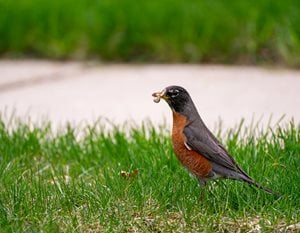Natural Ways to Get Rid of Grub Worms in Your Lawn
Discover five natural methods for treating and controlling lawn grubsGrub worms damage your lawn by feeding on the roots, and eventually turn into adult beetles that eat the leaves of other prized plants in your garden. Many homeowners simply treat their lawn with a chemical grub control product, or grub killer, once or twice a year. But there are also a number of natural methods that can be effective ways to get rid of grub worms. Check out the following tips from our readers on how to get rid of grubs naturally.
Q: I have white grub worms all over my garden and I hate to use pesticides. Are there any natural methods to get rid of them?
Answer 1: Earth-friendly beneficial nematodes seek out and kill grubs and other soil-inhabiting insects. They come on a sponge (invisible to naked eye) that you soak in water, put in a sprayer and spray your dirt or lawn. They will multiply over time and continue to kill grubs. They have nematodes that seek and destroy flea larvae too. Here's what one reader says about his experience with nematodes: "Works great. Did my yard last year, my dogs never have fleas unless we go someplace else. The nematodes for grubs work equally as well. Had them in my compost pile, wiped them out. No more grubs!" Buy nematodes on Amazon.
Answer 2: A naturally occurring pathogen, milky spore disease (Bacillus popilliae), affects beetle larvae and will kill grubs without harming you or your garden, but it can take one to three years to become fully effective. While you wait for the milky spore to become effective, try beneficial nematodes. Milky spore multiplies through infected grubs and can last 15 to 20 years in established lawns. Buy milky spore lawn mix on Amazon.
Answer 3: From another reader, “We once had a terrible time of it with grubs. Because we love birds, we just happened to put up 5 houses for house wrens, one in front yard, one in each side yard, and two in back — strategically placed so they would not see each other's houses, being so territorial. Since we did this, house wrens have nested every summer in every house. We have no more grubs, squash bugs, or tomato hornworms. It is almost unbelievable...but true. We never use pesticides of any kind and haven't for 18 years. We cannot prove that the house wrens eliminated all these insect pests, but watching them flying to and fro ALL DAY with insects in their beaks makes us believe that they are a gardener's best friends. Since grubs are the larvae of the June beetle, we assume that the house wrens are eliminating the beetles.” Buy wren houses on Amazon.
Answer 4: "I have been very successful controlling grubs by using only organic fertilizer once in the fall and once in late winter," says another reader. "Synthetic fertilizers tend to kill beneficial nematodes. The best fertilizer I have found (I have tried a lot) for lawns is Plant Tone. I use 1 large bag for 3,000 sq. ft. I live in zone 7 and have fescue (for now) grass. Hope this helps!” Buy Plant Tone fertilizer on Amazon.
Answer 5: Other readers have seen results using neem oil. Mix as directed with water and spray affected areas of your lawn to deter beetles from laying eggs, as well as keep grubs from feeding. Buy neem oil on Amazon.
Grubs and Your Lawn
Signs of grub problems:
- Damage to your lawn, especially dead patches of grass
- Your lawn feels spongy when walked on
- Turf that lifts easily off the soil surface
- Birds, skunks or moles digging up your grass
If you’re still unsure, pull back a section of lawn. If you see more than five grubs per square foot, you have a grub infestation and it's time to take action.
A healthy lawn will be able to withstand minor infestations, and should be able to outpace the damage.
When to treat for grubs: The best time to treat your lawn for grubs is in the spring or fall when they are active and feeding.Grubs 101: Grubs feed on the roots of grass and are the larvae of Japanese beetles, June beetles, European chafers, or other beetles. Adult female beetles lay their eggs in grass in mid-to-late summer and the larvae do the most damage in late summer to early fall. They burrow deeper and become dormant over winter. As the soil warms in spring, they resurface and grub feeding starts again before they cocoon and become adult beetles—and the life cycle begins again.
RELATED:
How to Get Rid of Spider Mites
Gardening Advice
When you purchase products through links on our site, we may receive an affiliate commission. Thank you for your support.
Last updated April 22, 2019


